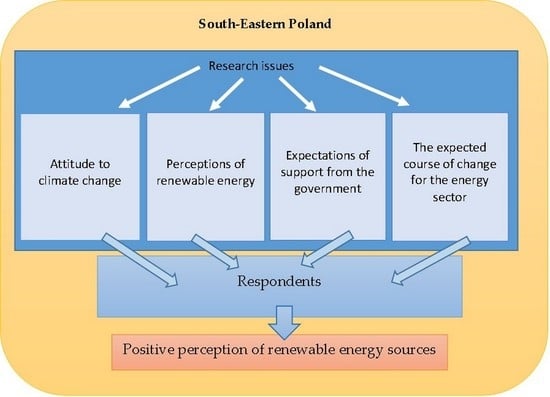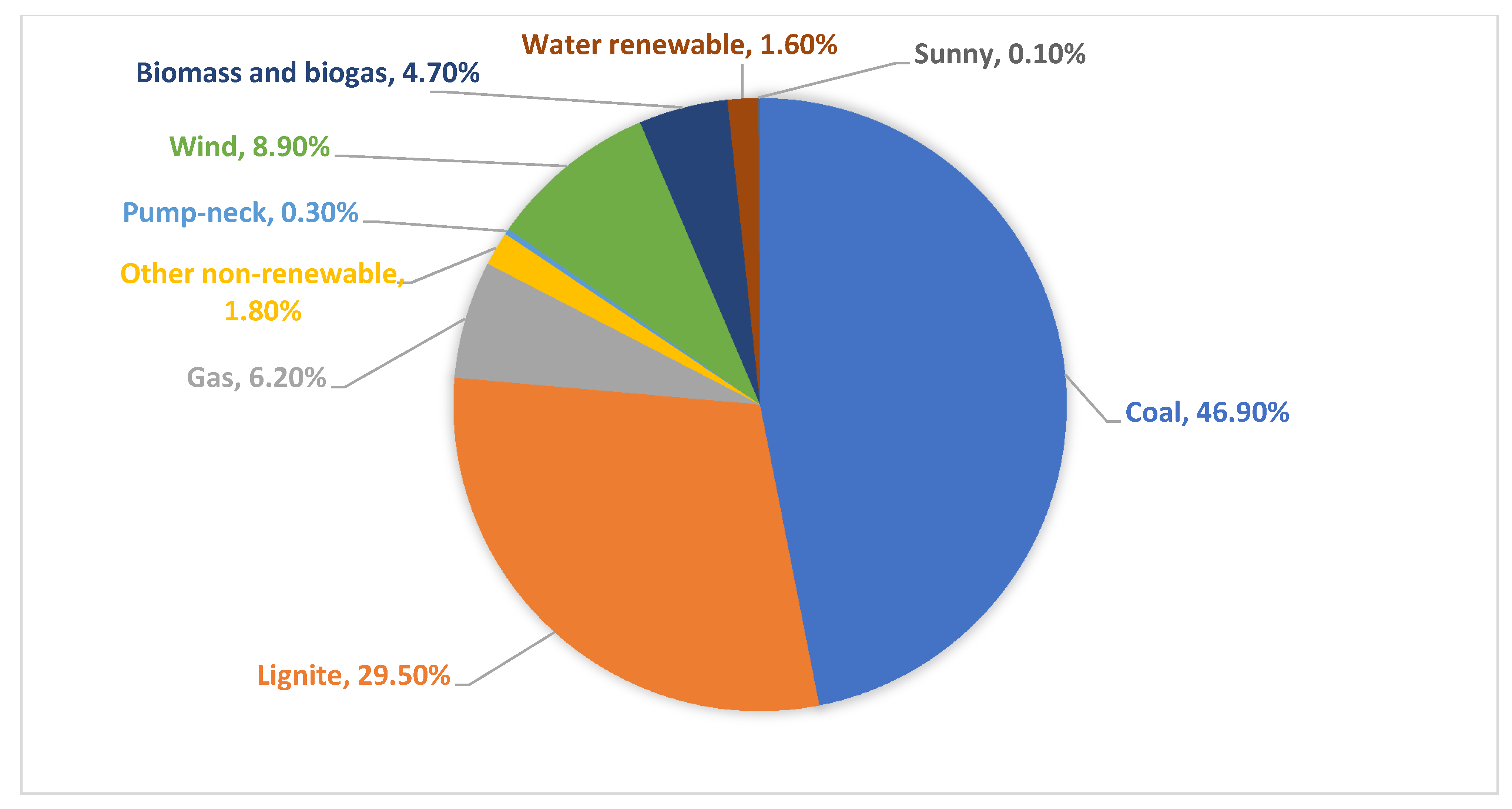Renewable Energy Sources as the Future of the Energy Sector and Climate in Poland—Truth or Myth in the Opinion of the Society
Abstract
:1. Introduction
2. Literature Review
2.1. The Energy Sector and Climate Change in the Opinion of Scientists and Society
2.2. Renewable Energy Sources in Poland’s Energy Mix and Their Impact on the Climate
- aging generation capacities based on coal combustion,
- the need to implement new restrictive emission reduction standards,
- limited possibilities of increasing domestic coal extraction,
- planned higher EU targets for the use of renewable energy sources,
- stopping the development of renewable energy on land,
- significant delay in the development of nuclear energy.
3. Materials and Methods
- How do the respondents perceive the issues of climate change? Do they see the importance of this issue?
- What is the perception of renewable energy sources? How positively do the respondents perceive RES?
- What actions on the part of the government do the respondents expect?
- What are the expectations of the respondents regarding the development of the energy sector in Poland?
- subject—residents of the study area aged 18–40;
- subject—perception of renewable energy;
- spatial—south-eastern Poland;
- temporal—from 21 June to 17 October 2021.
4. Results
- Cluster 1: 1—It is necessary to reduce consumption because of the finite resources of raw materials, especially energy. 3—Climate change is one of the most important threats to modern civilization. 4—Human activities have a decisive influence on the climate changes observed today. 6—Reducing carbon dioxide emissions is necessary to protect the climate. 10—The increasing demand for energy can be met by developing the use of renewable energy sources (RES). 18—Government administration should support the increase of RES-based energy. 19—Government administration should require that all electrical appliances sold meet the highest energy efficiency standards. 20—Government administration should introduce tax credits for people who renovate their homes to reduce heat loss. 21—Government should give tax breaks to businesses that seek to reduce energy losses.
- Cluster 2: 8—The European Union’s climate policy reduces global emissions of greenhouse gases, including carbon dioxide. 17—I accept bearing the cost of reducing carbon emissions to reduce climate change. 14—RESs create new jobs. 16—It is possible in the near future (20–30 years) to replace most conventional energy sources (coal, oil, gas, etc.) with renewable energy.
- Cluster 3: 2—It is necessary to reduce the human population due to increasing energy consumption, climate change, the problem of hunger.
- Cluster 4: 5—Climate change is mainly the business of certain groups making money by making societies fearful or guilty. 9—The European Union’s climate policy is a tool in the competitive game of European economies. 11—RESs are being introduced by force and threaten coal-fired power generation. 13—RESs are an unstable source of energy (production is unpredictable and mismatched with demand). 15—Wind turbines negatively affect their surroundings through a “shadow effect” and a lot of noise. 12—The cost of obtaining renewable energy is very high (renewable energy is expensive). 7—”Global warming” is merely a stage in the natural (human-independent) cyclical nature of climate change.
5. Discussion
6. Conclusions
- In the surveyed group of people, there is a belief that the observed climate changes are a serious, contemporary problem, even for three-quarters of the respondents it is one of the most important problems caused by people. They believe that all measures should be taken to reduce the anthropogenic pressure on the environment by limiting consumption, and a quarter expressed willingness to cover the possible costs of reducing carbon dioxide emissions in order to reduce climate change.
- Renewable energy sources were positively perceived by the respondents. Increasing the use of these energy sources was seen as a solution to the problem of the energy deficit, positive impact on the economy by creating new jobs. More than half of the respondents believe that renewable energy sources are not introduced by force and do not threaten coal-based energy.
- The surveyed group of people showed high expectations towards government support for all activities related to energy conservation. This is evidenced by the strong support for the theses relating to the forms of co-financing increasing the share of renewable energy sources in the energy mix and supporting investments that reduce energy waste.
- The respondents saw the need to restructure the Polish power system. Nearly 40% indicated the development of renewable energy and 30% on nuclear energy.
Author Contributions
Funding
Institutional Review Board Statement
Informed Consent Statement
Data Availability Statement
Conflicts of Interest
References
- Kundzewicz, Z.W.; Hov, Ǿ.; Okruszko, T. Zmiany Klimatu i ich Wpływ Na Wybrane Sektory w Polsce. Narodowe Centrum Badań i Rozwoju, Poznań. 2017. Available online: http://serwer1557491.home.pl/autoinstalator/wordpress/wp-content/uploads/2017/06/Zmiany-klimatu-i-ich-wpływ-na-wybrane-sektory-w-Polsce.pdf (accessed on 25 March 2021).
- Roberts, D. New Global Survey Reveals that Rveryone Loves Green Energy—Especially the Chinese. Available online: https://www.vox.com/energy-and-environment/2017/11/20/16678350/global-support-clean-energy (accessed on 21 August 2021).
- WMO. Provisional Statement on the State of the Global Climate in 2019. Available online: https://library.wmo.int/doc_num.php?explnum_id=10108 (accessed on 17 August 2021).
- Global Renewables. Energy Transformation 2050. Edition: 2020. IRENA 2020. Available online: https://www.irena.org/-/media/Files/IRENA/Agency/Publication/2020/Apr/IRENA_Global_Renewables_Outlook_2020.pdf (accessed on 5 November 2021).
- European Commission—DG Energy. Clean Energy for All Europeans. 2019. Available online: File:///C:/Users/ALEKSA~1/AppData/Local/Temp/RECG032017_European%20Commission.pdf (accessed on 9 November 2021).
- Decyzja wykonawcza Komisji (UE) 2017/1442 z Dnia 31 Lipca 2017 r. Ustanawiająca Konkluzje Dotyczące Najlepszych Dostępnych Technik (BAT) w Odniesieniu do Dużych Obiektów Energetycznego Spalania Zgodnie z Dyrektywą Parlamentu Europejskiego i Rady 2010/75/UE (notyfikowana jako dokument nr C(2017) 5225); Dz.Urz. UE L 212/1 z 17.08.2017 tzw. Konkluzje BAT. Available online: https://eur-lex.europa.eu/legal-content/EN/TXT/?uri=uriserv:OJ.L_.2017.212.01.0001.01.POL (accessed on 9 November 2021).
- Polska Odejdzie od Węgla do 2049 Roku. Available online: https://swiatoze.pl/w-koncu-polska-odejdzie-od-wegla-do-2049-roku-rzad-z-antynagroda-skamieliny-dnia (accessed on 5 November 2021).
- Impram, S.; Nese, S.; Oral, B. Challenges of renewable energy penetration on power system flexibility: A survey. Energy Strategy Rev. 2020, 31, 100539. [Google Scholar] [CrossRef]
- U.S. Global Change Research Program. Climate Science Special Report: Fourth National Climate Assessment; Wuebbles, D.J., Fahey, D.W., Hibbard, K.A., Dokken, D.J., Stewart, B.C., Maycock, T.K., Eds.; U.S. Global Change Research Program: Washington, DC, USA, 2017; Volume 1. Available online: https://science2017.globalchange.gov/downloads/CSSR2017_FullReport.pdf (accessed on 9 September 2021). [CrossRef] [Green Version]
- Friedlingstein, P.; Jones, M.W.; O’Sullivan, M.; Andrew, R.M.; Hauck, J.; Peters, G.P.; Peters, W.; Pongratz, J.; Sitch, S.; Le Quéré, C.; et al. Global carbon budget Earth Syst. Sci. Data 2019, 11, 1783–1838. [Google Scholar] [CrossRef]
- Voosen, P. Humans Held Responsible for Twists and Turns of Climate Change Since 1900. 2019. Available online: https://www.science.org/content/article/humans-held-responsible-twists-and-turns-climate-change-1900 (accessed on 10 September 2021).
- IPCC. IPCC Intergovernmental panel on climate change. IPCC, 2021: Summary for Policymakers. In Climate Change 2021: The Physical Science Basis; Masson-Delmotte, V., Zhai, P.A., Pirani, S.L., Connors, C., Péan, S., Berger, N., Caud, Y., Chen, L., Goldfarb, M.I., Go-mis, M., et al., Eds.; Contribution of Working Group I to the Sixth Assessment Report of the Intergovernmental Panel on Climate Change; Cambridge University Press: Cambridge, UK, 2021; in press. Available online: https://www.ipcc.ch/report/ar6/wg1/downloads/report/IPCC_AR6_WGI_Full_Report.pdf (accessed on 10 September 2021).
- Cook, J.; Oreskes, N.; Doran, P.T.; Anderegg, W.R.L.; Verheggen, B.; Maibach, E.W.; Carlton1, J.S.; Lewandowsky, S.; Skuce, A.G.; Green, S.A.; et al. Consensus on consensus: A synthesis of consensus estimates on human-caused global warming. Environ. Res. Lett. 2016, 11, 048002. Available online: https://iopscience.iop.org/article/10.1088/1748-9326/11/4/048002 (accessed on 10 September 2021). [CrossRef]
- Mathers, C. Climate Change and the Denial of Reality. 2019. Available online: https://colinmathers.com/2019/10/12/climate-change-and-the-denial-of-reality (accessed on 10 September 2021).
- Polityka Klimatyczna—Fakty i Mity. 2018. Warszawa, Heinrich BöllStiftung. Available online: https://pl.boell.org/sites/default/files/2018.07.06_1530_polityka_klimatyczna_fakty_i_mity_web.pdf (accessed on 6 July 2021).
- Steffen, W.; Rockström, J.; Richardson, K.; Lenton, T.; Folke, C.M.; Liverman, D.; Summerhayes, C.; Barnosky, A.D.; Cornell, S.; Crucifix, M.; et al. Trajectories of the System in the Anthropocene. PNAS 2018, 115, 8252–8259. Available online: https://pubmed.ncbi.nlm.nih.gov/30082409 (accessed on 21 August 2021). [CrossRef] [PubMed] [Green Version]
- Ankieta EBI Dotycząca Klimatu—Polacy są Mniej Zaniepokojeni Zmianą Klimatu Niż Inne Narody Europejskie. Available online: https://www.eib.org/attachments/press/2018-12-10-1st-survey-poland-pl.pdf (accessed on 10 November 2021).
- Polacy Wobec Zmian Klimatu. Komunikat z Badań. Nr 158/2018. Warszawa, Fundacja Centrum Badania Opinii Społecznej. Available online: https://www.cbos.pl/SPISKOM.POL/2018/K_158_18.PDF (accessed on 5 December 2021).
- Zielony Potencjał Społeczny. Polska i Europa Środkowo-Wschodnia. Available online: https://ibris.pl/wp-content/uploads/2020/07/IBRiS_ZIELONY-POTENCJA%C5%81-SPO%C5%81ECZNY_RAPORT.pdf (accessed on 26 June 2021).
- Wójcik, A.; Byrka, K. Raport z Badań Opinii Społecznej Dotyczącej Energetyki w Polsce, ENERGIA od NOWA, luty 2018. 2018. Available online: https://energiaodnowa.wwf.pl/wp-content/uploads/2019/04/RAPORT-Z-BADAN-SONDAZOWYCH-OPINII-SPOLECZNEJ-DOTYCZACEJ-ENERGETYKI-W-POLSCE-luty-2018.pdf (accessed on 5 March 2021).
- Rynek Fotowoltaiki w Polsce. Raport Instytutu Energetyki Odnawialnej. Warszawa. 2020. Available online: https://aviasolar.pl/wp-content/uploads/2021/05/Raport-Rynek-Fotowoltaiki-w-Polsce-2021.pdf (accessed on 29 May 2021).
- Interreg Europe. Available online: https://www.interregeurope.eu/policylearning/news/12610/commission-launches-the-fit-for-55-package/?no_cache=1&cHash=a371af17736f1f2f09030ee45e7dd6f2 (accessed on 29 May 2021).
- Energia ze Źródeł Odnawialnych w 2019 r. Główny Urząd Statystyczny, Warszawa. 2020. Available online: https://stat.gov.pl/obszary-tematyczne/srodowisko-energia/energia/energia-ze-zrodel-odnawialnych-w-2019-roku,10,3.html (accessed on 15 November 2021).
- Współpraca Konwencjonalnych Źródeł Węglowych i Wielkoskalowego OZE. Raport 2019. 2019. Available online: http://psew.pl/wp-content/uploads/2019/05/Raport-PSEW-DISE2019-Współpraca-konwencjonalnych-źródeł-węglowych-i-wielkoskalowego-OZE.pdf (accessed on 15 January 2021).
- Kamola-Cieślik, M. Założenia i Implementacja Programu Polskiego Rządu w Zakresie Bezpieczeństwa Energetycznego Polski w Kontekście Polityki Klimatyczna-Energetycznej Unii Europejskiej w Drugiej Dekadzie XXI Wieku. Bezpieczeństwo Teoria i Praktyka 2018, 1, 61–76. Available online: http://hdl.handle.net/11315/24639 (accessed on 23 September 2021).
- Bodzek, K. Modelowanie Trajektorii Transformacyjnych Energetyki do Elektroprosumeryzmu w Wybranych Osłonach Kontrolnych. Energetyka 2020, 11, 598–607. Available online: https://www.cire.pl/pliki/2/2021/modelowanie_trajektorii_transformacyjnych_1.pdf (accessed on 10 October 2021).
- Energy 2020 Warszawa 2020. Available online: https://stat.gov.pl/download/gfx/portalinformacyjny/pl/defaultaktualnosci/5485/1/8/1/energia_2020.pdf (accessed on 15 October 2021).
- Kielerz, A. Energetyka Węglowa i OZE—Wzajemne Uzupełnienie Czy Rywalizacja? Zesz. Nauk. Inst. Gospod. Surowcami Miner. Energią Pol. Akad. Nauk. 2018, 102, 217–230. Available online: https://yadda.icm.edu.pl/yadda/element/bwmeta1.element.baztech-a8e60198-fa4d-4602-bf01-777ba502cd6c/c/15-zn-21-kielarz.pdf (accessed on 15 October 2021).
- Polityka Energetyczna Polski do 2040 r. Ministerstwo Klimatu i Środowiska. Warszawa. 2021. Available online: https://bip.mos.gov.pl/strategie-plany-programy/polityka-energetyczna-polski-do-2040-r (accessed on 15 May 2021).
- Krajowy Plan na Rzecz Energii i Klimatu na Lata 2021–2030. Założenia i Cele Oraz Polityki i Działania. Available online: https://www.gov.pl/attachment/c216508a-1805-4376-bedc-ebac09d1566e (accessed on 15 January 2021).
- Szczerbowski, R. Energetyka Węglowa i Jądrowa Wybrane Aspekty. Wydawca Fundacja na rzecz Czystej Energii, wyd. 1. 2017. Available online: https://www.naukowa.pl/Ksiazki/energetyka-weglowa-i-jadrowa-wybrane-aspekty-1548606 (accessed on 24 September 2021).
- Szczerbowski, R.; Ceran, B. Polityka energetyczna Polski w aspekcie wyzwań XXI wieku. Polityka Energetyczna. Energy Policy J. 2017, 20, 17–28. Available online: https://min-pan.krakow.pl/wp-content/uploads/sites/4/2017/12/02-PE-05-Szczerbowski-Ceran.pdf (accessed on 15 October 2021).
- IRENA 2018. People, Planet and Prosperity. Raising Climate Ambitions through Renewables. Available online: https://www.irena.org/-/media/Files/IRENA/Agency/Publication/2019/Jul/IRENA_People-Planet-and-Prosperity_2019.pdf (accessed on 15 February 2021).
- Ahmed, F.E.; Hashaikeh, R.; Hilal, N. Hybrid technologies: The future of energy efficient desalination—A review. Desalination 2020, 495, 114659. [Google Scholar] [CrossRef]
- Clmate Change 2021. The Physical Science Basik. WGI: Working Group I contribution to the Sixth Assessment Report of the Intergovernmental Panel on Climate Chan. Available online: https://www.ipcc.ch/report/ar6/wg1 (accessed on 15 October 2021).
- IEA. Energy Technology Perspectives 2008: Scenarios and Strategies to 2050. Executive Summary. Available online: https://www.iea.org/reports/energy-technology-perspectives-2008 (accessed on 25 July 2021).
- Rozkrut, D. Editor-in-Chief of Editorial Board of Statistics Poland. Statistical Yearbook of the Republic of Poland 2020. Available online: https://stat.gov.pl/download/gfx/portalinformacyjny/pl/defaultaktualnosci/5515/2/20/1/rocznik_statystyczny_rzeczypospolitej_polskiej_2020_korekta_30.09.2021.pdf (accessed on 15 April 2021).
- Rybak-Wilusz, E.; Kut, P.; Sawicka-Chudy, P. State of energy production from solar photovoltaic systems in Poland. Gaz Woda Technika Sanit. 2019, 6, 186–189. [Google Scholar] [CrossRef]
- Parvin, P. Demokracja bez uczestnictwa: Nowa polityka dla niezaangażowanych er. Res Publica 2018, 24, 31–52. [Google Scholar] [CrossRef] [Green Version]
- Sloam, J.; Henn, M. Youthquake 2017. The Rise of Young Cosmopolitans in Britain. Palgrave Studies in Young People and Politics; Springer: Cham, Switzerland, 2019. [Google Scholar] [CrossRef] [Green Version]
- Chyung, S.Y.; Roberts, K.; Swanson, I.; Hankinson, A. Evidence-Based Survey Design: The Use of a Midpoint on the Likert Scale. Perform. Improv. 2017, 56, 15–23. [Google Scholar] [CrossRef] [Green Version]
- Ventocilla, E.; Riveiro, M. A comparative user study of visualization techniques for cluster analysis of multidimensional data sets. Inf. Vis. 2020, 19, 318–338. [Google Scholar] [CrossRef]
- Härdle, W.K.; Simar, L. Cluster Analysis. In Applied Multivariate Statistical Analysis; Springer: Cham, Switzerland, 2019. [Google Scholar] [CrossRef]
- Agboola, S.; Joel, M.B.M. Classification of Some Seasonal Diseases: A Hierarchical Clustering Approach. Biomed. Stat. Inform. 2017, 2, 122–127. [Google Scholar] [CrossRef]
- Bielecka, A. Statystyka dla Menedżerów. Teoria i Praktyka (Statistics for Managers. Theory and Practice); Wolters Kluwer Polska: Warszawa, Poland, 2011; ISBN 9788363391386. [Google Scholar]
- Aczel, A.D. Statystyka w Zarządzaniu; Original: Aczel, A.D. Complete Business, Statistics, Wydawnictwo Naukowe PWN Warszawa. 2018. Available online: https://ksiegarnia.pwn.pl/Statystyka-wzarzadzaniu,731934758,p.html (accessed on 5 November 2021).
- Crowley, T.J. Causes of Climate Change Over the Past 1000 Years. Science 2021, 289, 270–277. [Google Scholar] [CrossRef] [Green Version]
- Konferencja Klimatyczna ONZ w Glasgow (COP26)—Światowy Szczyt Przywódców, 1 Listopada 2021. Available online: https://www.consilium.europa.eu/pl/meetings/international-summit/2021/11/01/# (accessed on 10 June 2021).
- Ripple, W.J.; Wolf, C.; Newsome, T.M.; Barnard, P.; William, R. World Scientists’ Warning of a Climate Emergency. Moomaw 11,258 scientist signatories from 153 countries. BioScience 2020, 70, 8–12. [Google Scholar] [CrossRef]
- Batkins, S.; Rossetti, P.; Goldbeck, D. The Costs and Benefits of Using Regulation to Achieve Climate Goals. Available online: https://www.americanactionforum.org/research/costs-benefits-using-regulation-achieve-climate-goals (accessed on 19 October 2021).
- Renewable Power Generation Costs in 2020. IRENA 2021. Available online: https://www.irena.org/-/media/Files/IRENA/Agency/Publication/2021/Jun/IRENA_Power_Generation_Costs_2020.pdf (accessed on 15 May 2021).
- Krzykowski, M.; Zięty, J.J. Milestone for Energy Solidarity Principle—Implication of the Judgment of the General Court of 10.09.2019 (T-883/16) for energy policy. Prz. Ustawodawstwa Gospodarczego 2020, 4, 39–44. [Google Scholar] [CrossRef]
- Huijts, N.M.A.; Molin, E.J.; Steg, L. Psychological factors influencing sustainable energy technology acceptance: A review-based comprehensive framework. Renew. Sustain. Energy Rev. 2012, 16, 525–531. [Google Scholar] [CrossRef]
- Europeans Support New Wind and Solar Projects in Their Local Area. Available online: https://europeanclimate.org/resources/europeans-support-new-wind-and-solar-projects-in-their-local-area (accessed on 20 October 2021).
- Polityka Energetyczna Niemiec i jej Wpływ na Bezpieczeństwo Energetyczne Polski i Europy. Available online: https://se.min-pan.krakow.pl/pelne_teksty32/k32_prezentacje/k32se_szerbowski.pdf (accessed on 20 October 2021).
- Trzeszczyński, J. Diagnostyka towarzysząca transformacji energetyki. Nowa Energ. 2021, 2, 75–84. Available online: https://yadda.icm.edu.pl/baztech/element/bwmeta1.element.baztech-b3655043-cd25-4c9a-85dd-bb5fe609db05 (accessed on 15 November 2021).
- Parlaviciute, G.; Steg, L. Contextual and psychological factors shaping evaluations and acceptability of energy alternatives: Integrated review and research agenda. Energy Rev. 2014, 35, 361–381. [Google Scholar] [CrossRef]
- Atlas Energii. Fakty i Dane o Energetyce Odnawialnej w Europie. Heinrich Böll Stiftung Instytur na Rzecz Ekorozwoju. Warszawa. 2018. Available online: https://pl.boell.org/sites/default/files/atlas_energii.pdf (accessed on 20 October 2021).
- Newbery, D.; Pollitt, M.G.; Ritz, R.A.; Strielkowski, W. Market design for a high-renewables European electricity system. Renew. Sustain. Energy Rev. 2018, 91, 695–707. [Google Scholar] [CrossRef] [Green Version]
- Pan, S.-L.; Chou, J.; Morrison, A.M.; Huang, W.-S.; Lin, M.-C. Will the Future Be Greener? The Environmental Behavioral Intentions of University Tourism Students. Sustainability 2018, 10, 634. [Google Scholar] [CrossRef] [Green Version]
- Perlaviciute, G.; Squintani, L. Public Participation in Climate Policy Making: Toward Reconciling Public Preferences and Legal Frameworks. One Earth 2020, 2, 341–348. [Google Scholar] [CrossRef]
- Liebe, U.; Dobers, G.M. Decomposing public support for energy policy: What drives acceptance of and intentions to protest against renewable energy expansion in Germany? Energy Res. Soc. Sci. 2019, 47, 247–260. [Google Scholar] [CrossRef] [Green Version]
- Sposato, R.G.; Hampl, N. Worldviews as predictors of wind and solar energy support in Austria: Bridging social acceptance and risk perception research. Energy Res. Soc. Sci. 2018, 42, 237–246. [Google Scholar] [CrossRef]
- Mehrasa, M.; Pouresmaeil, E.; Pournazarian, B.; Sepehr, A.; Marzband, M.; Catalão, J.P.S. Synchronous Resonant Control Technique to Address Power Grid Instability Problems Due to High Renewables Penetration. Energies 2018, 11, 2469. [Google Scholar] [CrossRef] [Green Version]
- Li, L.; Li, H.; Tseng, M.-L.; Feng, H.; Chiu, A.S.F. Renewable Energy System on Frequency Stability Control Strategy Using Virtual Synchronous Generator. Symmetry 2020, 12, 1697. [Google Scholar] [CrossRef]
- Boričić, A.; Torres, J.L.R.; Popov, M. Comprehensive Review of Short-Term Voltage Stability Evaluation Methods in Modern Power Systems. Energies 2021, 14, 4076. [Google Scholar] [CrossRef]
- Zimon, G.; Sobolewski, M.; Lew, G. An Influence of Group Purchasing Organizations on Financial Security of SMEs Operating in the Renewable Energy Sector—Case for Poland. Energies 2020, 13, 2926. [Google Scholar] [CrossRef]
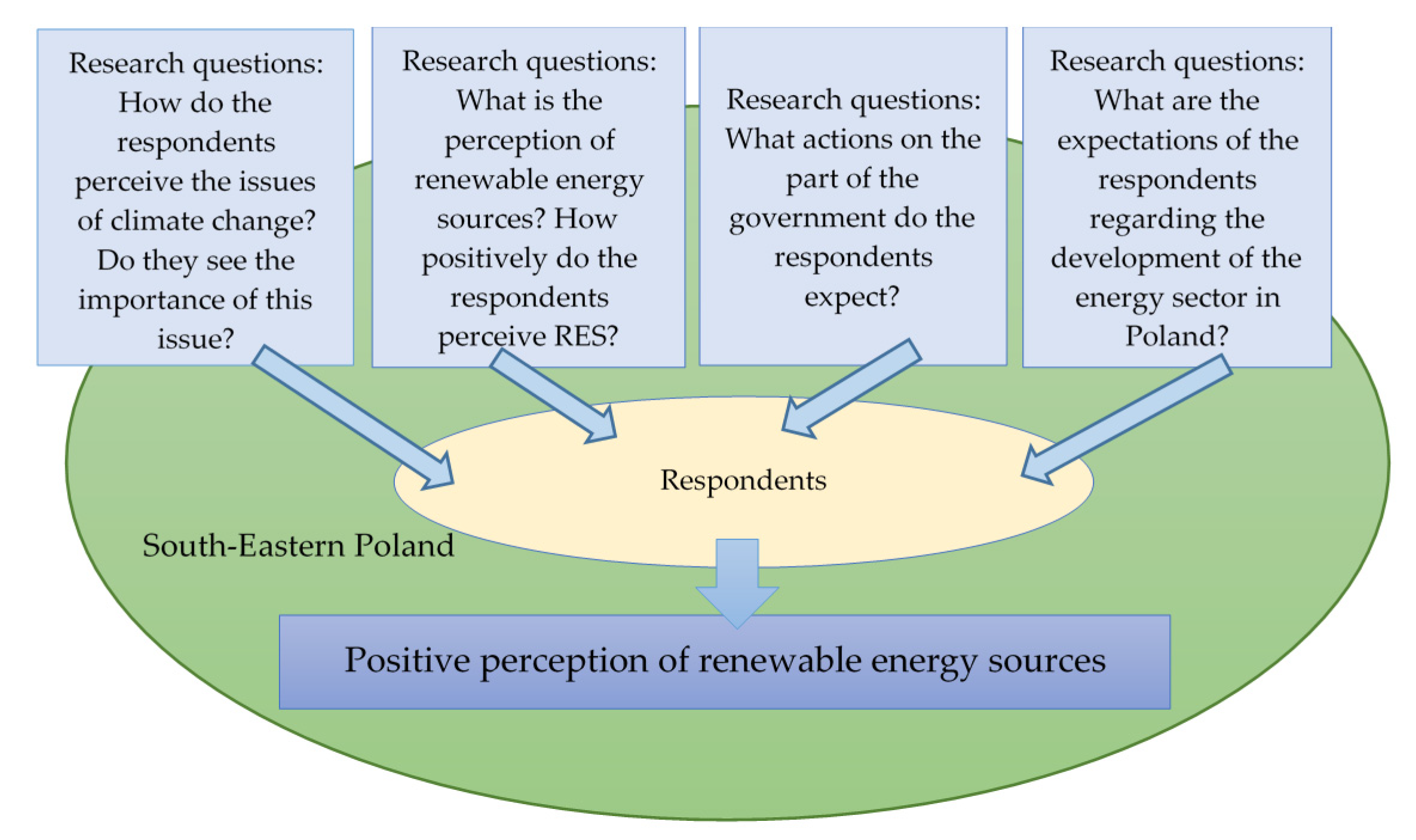
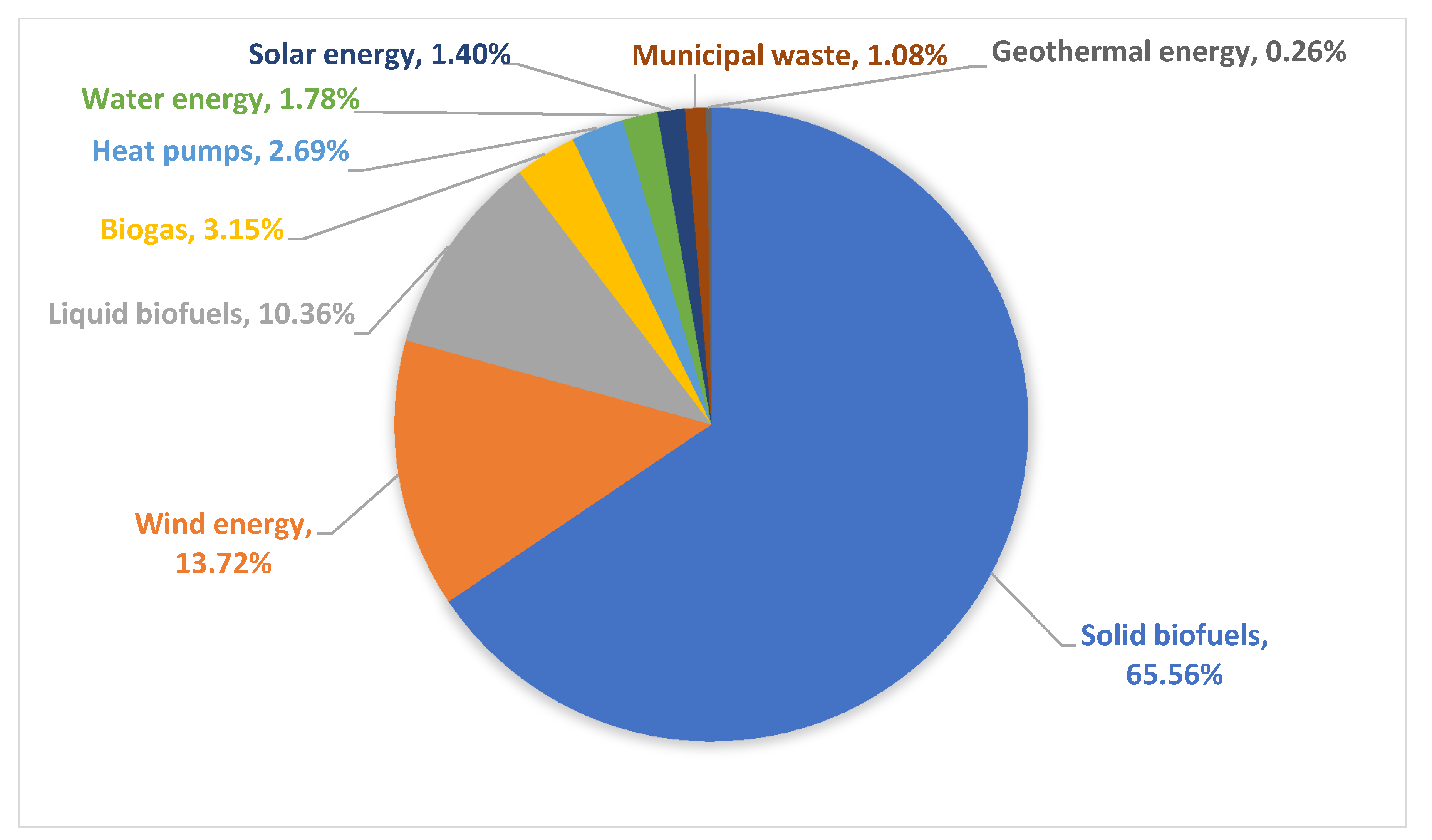

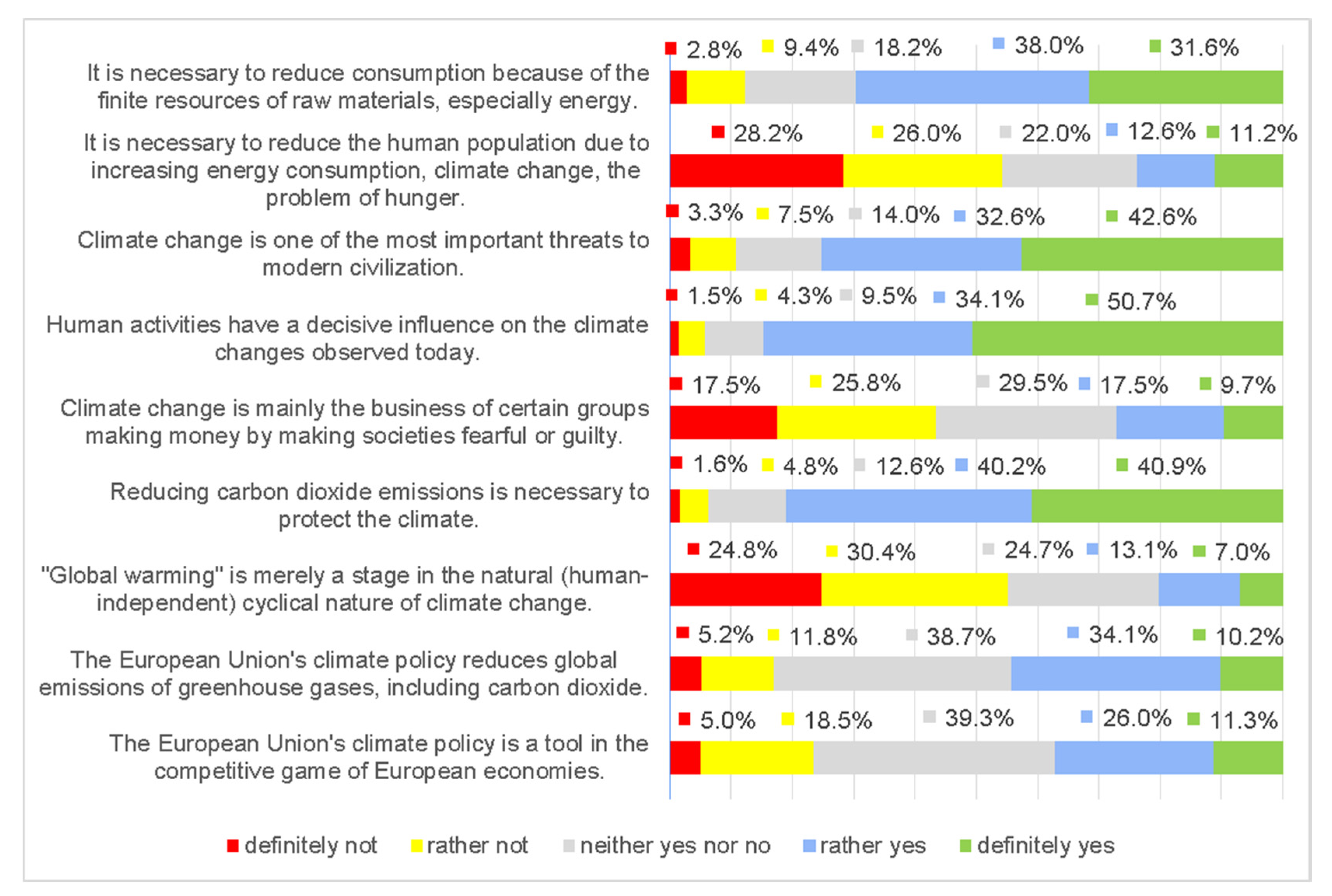
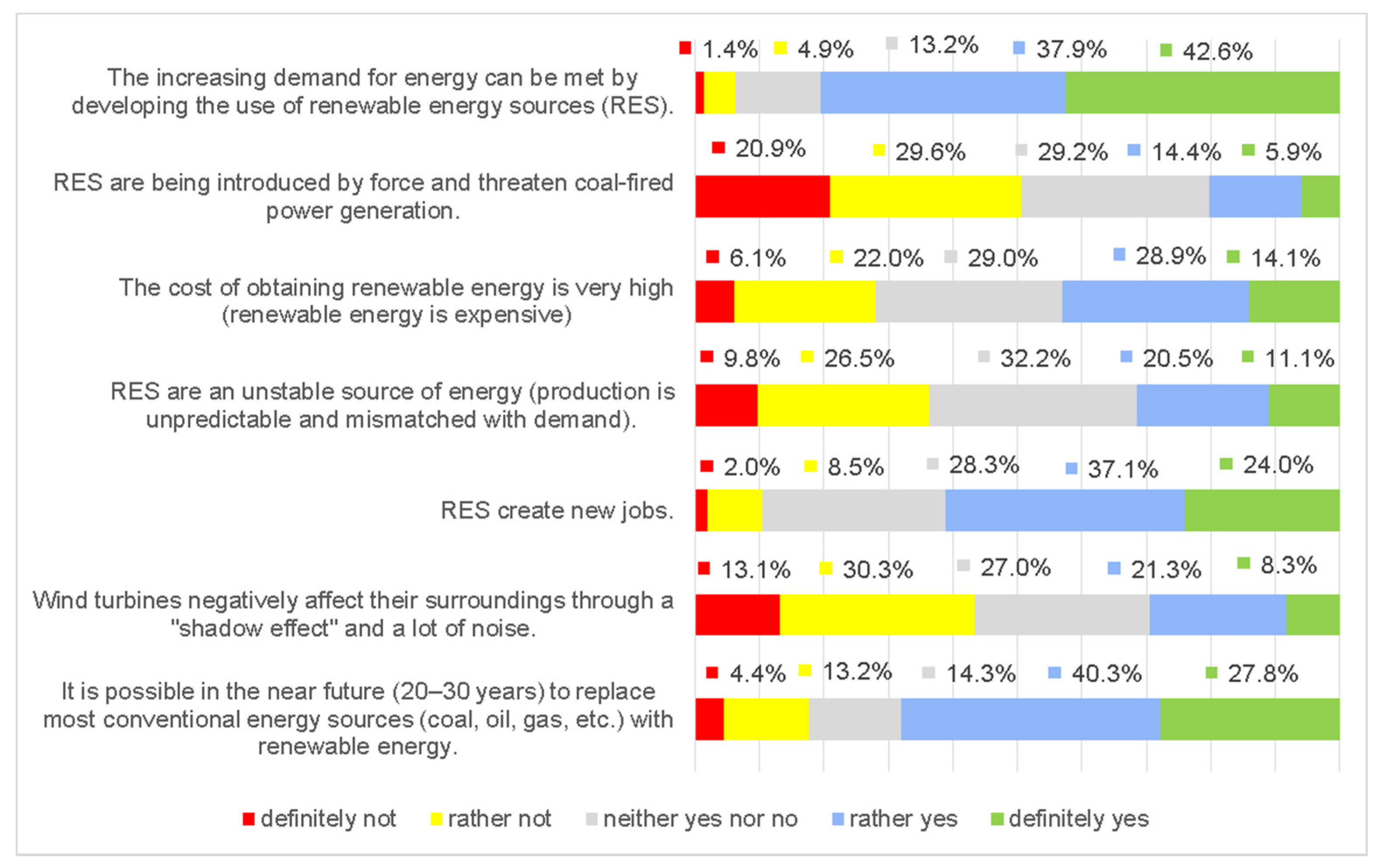
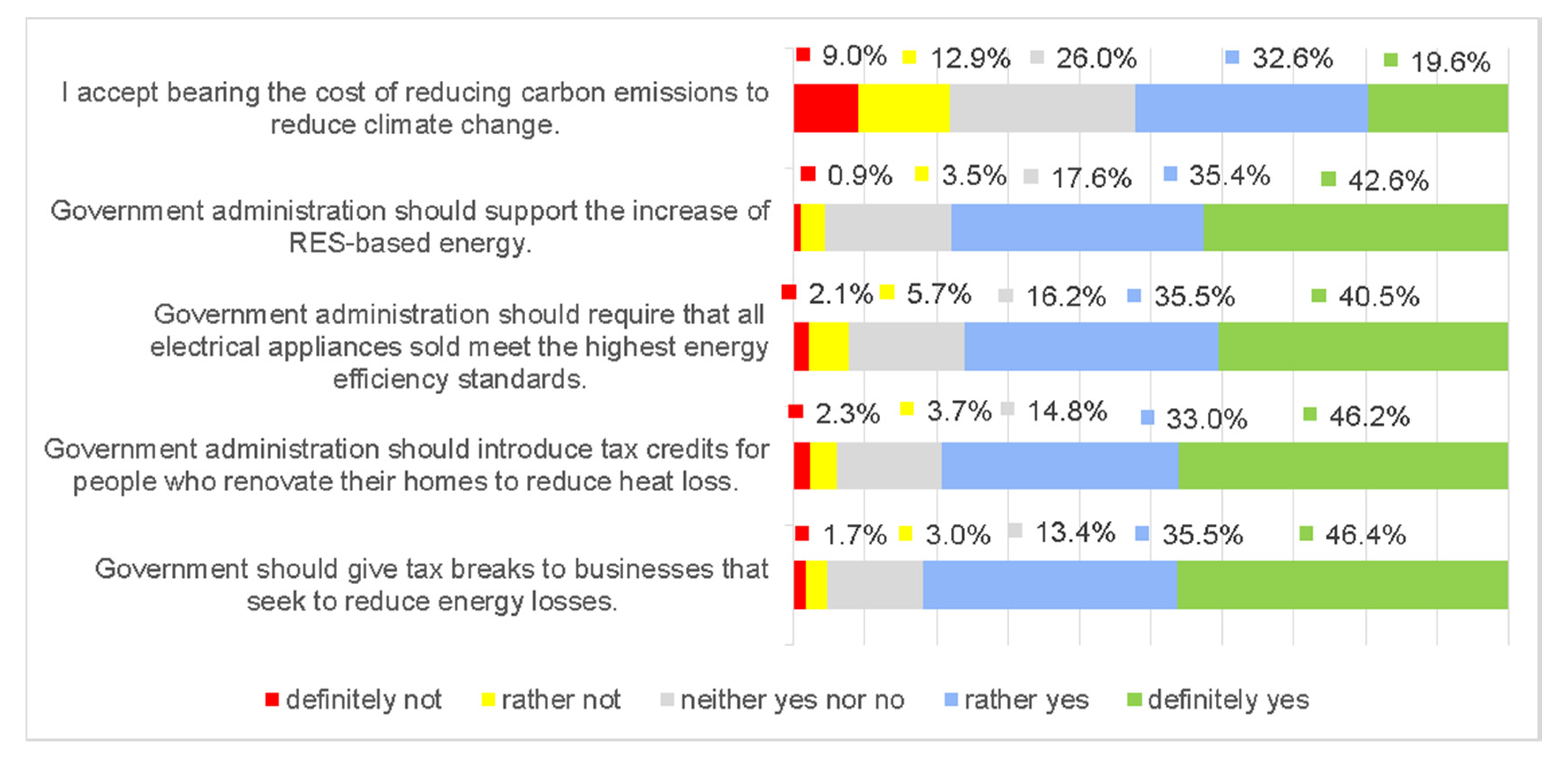

| Definitely Not | Probably Not | Neither Yes Nor No | Probably Yes | Definitely Yes | Average | |
|---|---|---|---|---|---|---|
| Preferred types of power plants | ||||||
| Solar | 3 | 3 | 19 | 29 | 46 | 4.12 |
| Wind | 4 | 8 | 22 | 27 | 41 | 3.95 |
| Water | 3 | 6 | 22 | 30 | 39 | 3.96 |
| Geothermal | 4 | 5 | 33 | 27 | 31 | 3.77 |
| Biomass | 8 | 9 | 34 | 30 | 19 | 3.43 |
| The ecological dimension of the method of generating energy | ||||||
| Solar | 2 | 4 | 18 | 19 | 58 | 4.27 |
| Wind | 3 | 4 | 21 | 24 | 49 | 4.12 |
| Water | 2 | 2 | 24 | 24 | 48 | 4.13 |
| Geothermal | 2 | 5 | 28 | 30 | 35 | 3.91 |
| Biomass | 5 | 9 | 40 | 28 | 17 | 3.44 |
| The social dimension of the method of generating energy | ||||||
| Solar | 1 | 3 | 16 | 22 | 58 | 4.33 |
| Wind | 3 | 6 | 26 | 29 | 36 | 3.87 |
| Water | 1 | 3 | 24 | 29 | 43 | 4.09 |
| Geothermal | 2 | 5 | 28 | 29 | 36 | 3.93 |
| Biomass | 5 | 13 | 35 | 31 | 16 | 3.44 |
| The economic dimension of the method of generating energy | ||||||
| Solar | 3 | 3 | 24 | 25 | 45 | 4.06 |
| Wind | 2 | 6 | 27 | 26 | 29 | 3.94 |
| Water | 1 | 6 | 27 | 28 | 37 | 3.95 |
| Geothermal | 3 | 6 | 33 | 33 | 25 | 3.71 |
| Biomass | 4 | 9 | 38 | 31 | 17 | 3.48 |
| Type of RES | Installation Capacity in the World in MW | Installation Capacity in Poland in MW | Important Features |
|---|---|---|---|
| Water energy | 1,171,612 | 969 | Very efficient. Requires a suitable place for installation. |
| Wind energy | 563,726 | 5777 | It does not occupy a large area of land. Requires appropriate weather conditions. |
| Solar energy | 485,826 | 486.5 | Cheap and efficient. Requires proper installation. The panels can be installed anywhere. |
| Energy from biomass | 115,731 | 1002 | Application for the production of electricity and biofuels and for heating. Requires access to raw material. |
| Together with RES | 2,336,895 | 8234.5 |
| Thesis | Average | Ranking of Averages | SD | Ranking SD |
|---|---|---|---|---|
| It is necessary to limit consumption due to the depleting resources of raw materials, especially energy ones. | 3.86 | 9 | 1.05 | 12 |
| It is necessary to reduce the human population due to increasing energy consumption, climate change, and the problem of hunger. | 2.52 | 21 | 1.32 | 1 |
| Climate change is one of the most important threats to modern civilization. | 4.04 | 8 | 1.08 | 11 |
| Human activity has a decisive influence on the currently observed climate changes. | 4.28 | 1 | 0.91 | 20 |
| Climate change is mainly the business of certain earning groups by arousing fear or guilt in societies. | 2.76 | 19 | 1.21 | 3 |
| Limiting CO2 emissions is necessary to protect the climate. | 4.14 | 6 | 0.92 | 19 |
| “Global warming” is only a part of the natural (non-human) cyclicality of climate change. | 2.47 | 22 | 1.20 | 5 |
| The climate policy of the European Union reduces global greenhouse gas emissions, including CO2. | 3.32 | 13 | 0.99 | 15 |
| The climate policy of the European Union is a tool for the competitive game of European economies. | 3.20 | 16 | 1.03 | 13 |
| The growing demand for energy can be covered by developing the use of renewable energy sources (RESs). | 4.15 | 4 | 0.93 | 18 |
| RESs are introduced by force and threaten the coal energy sector. | 2.55 | 20 | 1.14 | 7 |
| The cost of obtaining renewable energy is very high (renewable energy is expensive). | 3.23 | 15 | 1.12 | 10 |
| RESs are an unstable source of energy (production is unpredictable and not adjusted to the demand). | 2.97 | 17 | 1.14 | 8 |
| RESs create new jobs. | 3.73 | 11 | 0.98 | 16 |
| Wind power plants have a negative impact on the surroundings due to the “shadow effect” and high noise levels. | 2.81 | 18 | 1.16 | 6 |
| It is possible in the near future (20–30 years) to replace most conventional energy sources (coal, oil, gas, etc.) with renewable energy. | 3.74 | 10 | 1.13 | 9 |
| I accept the cost of reducing carbon dioxide emissions to limit climate change. | 3.41 | 12 | 1.20 | 4 |
| The government administration should support the increase in the share of energy based on renewable energy. | 4.15 | 5 | 0.90 | 22 |
| Government administration should require that all electrical appliances sold meet the highest energy efficiency standards. | 4.07 | 7 | 0.99 | 14 |
| The government administration should introduce tax breaks for people who renovate houses in order to reduce heat losses. | 4.17 | 3 | 0.97 | 17 |
| The government administration should grant tax breaks to companies that seek to reduce energy losses. | 4.22 | 2 | 0.91 | 21 |
| Thesis Numbers | Thesis Numbers | ||||||
|---|---|---|---|---|---|---|---|
| 1 | 2 | 3 | 4 | 5 | 6 | 7 | |
| 8 | 0.1900 * | 0.2548 * | 0.3069 * | 0.2028 * | −0.1371 * | −0.1412 * | −0.1362 * |
| 9 | 0.1505 * | 0.1629 * | 0.1817 * | 0.1455 * | −0.0582 | −0.0697 * | −0.0767 * |
| 10 | 0.2200 * | 0.2279 * | 0.3321 * | 0.1773 * | −0.0761 * | −0.1118 * | −0.1374 * |
| 11 | −0.1758 * | −0.1823 * | −0.2602 * | −0.1280 * | 0.3729 * | 0.2836 * | 0.3109 * |
| 12 | −0.0753 * | −0.0599 | −0.0309 | −0.0110 | 0.1543 * | 0.1289 * | 0.1610 * |
| 13 | −0.1890 * | −0.1909 * | −0.1889 * | −0.1228 * | 0.2767 * | 0.2706 * | 0.2823 * |
| 14 | −0.0998 * | −0.1237 * | −0.1514 * | 0.0014 | 0.1885 * | 0.2359 * | 0.2231 * |
| 15 | 0.3798 * | 0.2992 * | 0.3913 * | 0.2747 * | −0.1292 * | −0.2815 * | −0.2288 * |
Publisher’s Note: MDPI stays neutral with regard to jurisdictional claims in published maps and institutional affiliations. |
© 2021 by the authors. Licensee MDPI, Basel, Switzerland. This article is an open access article distributed under the terms and conditions of the Creative Commons Attribution (CC BY) license (https://creativecommons.org/licenses/by/4.0/).
Share and Cite
Woźniak, M.; Badora, A.; Kud, K.; Woźniak, L. Renewable Energy Sources as the Future of the Energy Sector and Climate in Poland—Truth or Myth in the Opinion of the Society. Energies 2022, 15, 45. https://doi.org/10.3390/en15010045
Woźniak M, Badora A, Kud K, Woźniak L. Renewable Energy Sources as the Future of the Energy Sector and Climate in Poland—Truth or Myth in the Opinion of the Society. Energies. 2022; 15(1):45. https://doi.org/10.3390/en15010045
Chicago/Turabian StyleWoźniak, Marian, Aleksandra Badora, Krzysztof Kud, and Leszek Woźniak. 2022. "Renewable Energy Sources as the Future of the Energy Sector and Climate in Poland—Truth or Myth in the Opinion of the Society" Energies 15, no. 1: 45. https://doi.org/10.3390/en15010045
APA StyleWoźniak, M., Badora, A., Kud, K., & Woźniak, L. (2022). Renewable Energy Sources as the Future of the Energy Sector and Climate in Poland—Truth or Myth in the Opinion of the Society. Energies, 15(1), 45. https://doi.org/10.3390/en15010045







